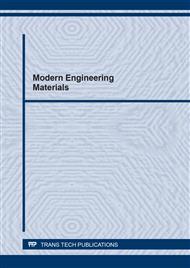[1]
A. Dzigbor and A. Chimphango, Production and optimization of NaCl-activated carbon from mango seed using response surface methodology, Biomass Convers. Biorefinery, (2019)16–18, (2019).
DOI: 10.1007/s13399-018-0361-3
Google Scholar
[2]
J. Pallarés, A. González-cencerrado, and I. Arauzo, Biomass and Bioenergy Production and characterization of activated carbon from barley straw, Biomass Bioenergy J., 115(2018) 64–73, (2018).
DOI: 10.1016/j.biombioe.2018.04.015
Google Scholar
[3]
I. Jones et al., The application of spent tyre activated carbons as low-cost environmental pollution adsorbents: A technical review, J. Clean. Prod., 312 (2021) 127566.
DOI: 10.1016/j.jclepro.2021.127566
Google Scholar
[4]
H. S. Karapınar, Adsorption performance of activated carbon synthesis by ZnCl2, KOH, H3PO4 with different activation temperatures from mixed fruit seeds, Environ. Technol. (United Kingdom), (2021) 1–19.
DOI: 10.1080/09593330.2021.1968507
Google Scholar
[5]
B. A. A. Alongamo, L. D. Ajifack, J. N. Ghogomu, N. J. Nsami, and J. M. Ketcha, Activated Carbon from the Peelings of Cassava Tubers (Manihot esculenta) for the Removal of Nickel(II) Ions from Aqueous Solution, J. Chem., 2021 (2021).
DOI: 10.1155/2021/5545110
Google Scholar
[6]
T. Mkungunugwa, S. Manhokwe, A. Chawafambira, and M. Shumba, Synthesis and Characterisation of Activated Carbon Obtained from Marula (Sclerocarya birrea) Nutshell, J. Chem., 2021 (2021).
DOI: 10.1155/2021/5552224
Google Scholar
[7]
A. Ahmad, H. M. Al-swaidan, and A. H. Alghamdi, Preparation and Characterization of Activated Carbon from Date Fronds Biomass by Chemical Activation, ASIAN J. Chem., 26, 22 (2014) 7833–7836.
DOI: 10.14233/ajchem.2014.17969
Google Scholar
[8]
O. Houache, R. Al-Maamari, B. Al-Rashidi, and B. Jibril, Study of Date Palm Stem as Raw Material in Preparation of Activated Carbon, J. Eng. Res. 5, 1 (2008) 47–54.
DOI: 10.24200/tjer.vol5iss1pp47-54
Google Scholar
[9]
M. J. Ahmed, Preparation of activated carbons from date ( Phoenix dactylifera L .) palm stones and application for wastewater treatments : Review, Process Saf. Environ. Prot., 102 (2016) 168–182.
DOI: 10.1016/j.psep.2016.03.010
Google Scholar
[10]
V. Benedetti, F. Patuzzi, and M. Baratieri, Characterization of char from biomass gasification and its similarities with activated carbon in adsorption applications, Appl. Energy, vol. 227(2018) 92–99.
DOI: 10.1016/j.apenergy.2017.08.076
Google Scholar
[11]
M. Shoaib and H. M. Al-swaidan, Optimization and characterization of sliced activated carbon prepared from date palm tree fronds by physical activation, Biomass and Bioenergy,73 (2015) 124–134.
DOI: 10.1016/j.biombioe.2014.12.016
Google Scholar
[12]
R. Carlos et al., Buriti palm stem as a potential renewable source for activated carbon production," Environ. Technol. Innov., 3 (2015) 28–34.
Google Scholar
[13]
S. Rezma, M. Birot, H. Amor, and D. Herve, Physically activated microporous carbon from a new biomass source : Date palm petioles, Comptes Rendus Chim., 20 (2017) 881–887.
DOI: 10.1016/j.crci.2017.05.003
Google Scholar
[14]
A. Ahmad, H. M. Al-swaidan, and A. H. Alghamdi, Production of Activated Carbon from Raw Date Palm Fronds by ZnCl2 Activation, Chem. Soc. Pakistan, 37, 6 (2015) 1081–1087.
Google Scholar
[15]
A. E. Ogungbenro, D. V Quang, K. A. Al-ali, and L. F. Vega, Synthesis and characterization of activated carbon from date seeds for CO 2 capture, J. Environ. Chem. Eng., 6 (2018) 4245–4252.
DOI: 10.1016/j.jece.2018.06.030
Google Scholar
[16]
M. Daoud, O. Benturki, Z. Kecira, P. Girods, and A. Donnot, Removal of Reactive dye (BEZAKTIV Red S-MAX) from Aqueous Solution by Adsorption onto Activated Carbons Prepared from Date Palm Rachis and Jujube Stones, J. Mol. Liq., 243 (2017)799–809.
DOI: 10.1016/j.molliq.2017.08.093
Google Scholar
[17]
F. H. Hussein, A. F. Halbus, A. J. Lafta, and Z. H. Athab, Preparation and Characterization of Activated Carbon from Iraqi Khestawy Date Palm, J. Chem., 2015 (2015).
DOI: 10.1155/2015/295748
Google Scholar
[18]
P. Germain, L. D. T. Minerale, I. De Lyon, and A. A. Einstein, Adsorption of methylene blue from an palm-tree cobs, Carbon N. Y., 353 (1997) 365–369.
DOI: 10.1016/s0008-6223(96)00158-3
Google Scholar
[19]
O. F. Okeola, E. O. Odebunmi, and O. M. Ameen,Comparison of sorption capacity and surface area of activated carbon prepared from Jatropha curcas fruit pericarp and seed coat, Chem. Soc. Ethiop., 26, 2 (2012) 171–180.
DOI: 10.4314/bcse.v26i2.2
Google Scholar
[20]
P. Tarapitakcheevin, P. Weerayutsil, and K. Khuanmar, Adsorption of Acid Dye on Activated Carbon Prepared from Water Hyacinth by Sodium Chloride Activation, GMSARN Int. J. 7, (2013) 83–90.
Google Scholar
[21]
C. E. Gimba, O. Ocholi, P. A. Egwaikhide, T. Muyiwa, and E. E. Akporhonor, New raw material for activated carbon . I . Methylene blue adsorption on activated carbon prepared from Khaya senegalensis fruits, Cien. Inv. Agr., 36, 1 (2009) 107–114.
DOI: 10.4067/s0718-16202009000100010
Google Scholar
[22]
D. Liu, R. Su, Z. Hao, X. Zhao, B. Jia, and L. Dong, Catalytic Effect of NaCl on the Improvement of the Physicochemical Structure of Coal-Based Activated Carbons for SO2 Adsorption, processes, 338, 7 (2019).
DOI: 10.3390/pr7060338
Google Scholar
[23]
S. Zietek, S. Andrzej, S. Radoslaw, P. Dorota, and S.-Z. Jadwiga, Influence of Presence of Inert Impregnant ( NaCl ) on Adsorptive Characteristics of Activated Carbon, Adsorption, 11 (2005) 715–718.
DOI: 10.1007/s10450-005-6012-6
Google Scholar
[24]
C. A. Nunes and M. C. Guerreiro, Estimation of surface area and pore volume of activated carbons by methylene blue and iodine numbers, Quim. Nova, 34, 3 (2011) 472–476.
DOI: 10.1590/s0100-40422011000300020
Google Scholar
[25]
L. Z. Leea and M. A. A. Zaini, Metal chloride salts in the preparation of activated carbon and their hazardous outlook, Desalin. Water Treat., (2015) 1–8.
Google Scholar
[26]
K. Eda and A.-B. Canan, Preparation , structural evaluation and adsorptive properties of activated carbon from agricultural waste biomass, Adv. Powder Technol. J., 26 (2015) 811–818.
DOI: 10.1016/j.apt.2015.02.006
Google Scholar
[27]
R. H. Hesas, A. Arami-niya, W. Mohd, A. Wan, and J. N. Sahu, Preparation and Characterization of Activated Carbon, bioresources, 8, 2 (2013) 2950–2966.
DOI: 10.15376/biores.8.2.2950-2966
Google Scholar


